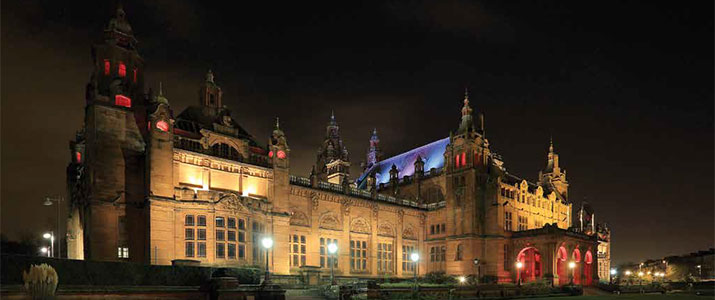
The Art of Security
Keeping the king’s ransom well within reach
- By Vicki Contavespi
- May 01, 2014
 Museums are complicated for security professionals. They must
be open and welcoming to the public, but they often have quiet
nooks and crannies where patrons sit and ponder the art
and human endeavor on display. Museums acquire, conserve
and exhibit extraordinarily rare pieces of art and antiquities,
sometimes jewels, and all of them are worth more than a king’s ransom.
Museums are complicated for security professionals. They must
be open and welcoming to the public, but they often have quiet
nooks and crannies where patrons sit and ponder the art
and human endeavor on display. Museums acquire, conserve
and exhibit extraordinarily rare pieces of art and antiquities,
sometimes jewels, and all of them are worth more than a king’s ransom.
Usually, every couple of years, someone pulls off a major art theft. For example,
two versions of Edvard Munch’s “The Scream” were stolen: one from the
Munch Museum in Oslo, Norway and another from Oslo’s National Gallery—but
each were recovered. In 1990, however, fake mustaches were used in part; allowing
thieves to enter Boston’s Isabella Gardner Museum and, in broad daylight, three
Rembrandts, five Degas sketches, a Vermeer, a Manet and a bronze eagle that
topped a framed, Napoleon-era banner were removed. These pieces have never
been recovered, although the museum continues to investigate and is offering a $5
million reward.
Even though headline-making thefts occur, it’s not for lack of resolve on the
part of the security staff.
Securing Valuable Pieces of Art
All museums employ a variety of security precautions, as some thieves resort to
diverting police forces with bombs, brandishing weapons during their assault or
even tunneling into the building. While a bomb may be difficult to defeat, Steven
R. Keller, a well-known security consultant for museums and libraries, said that
the most basic solution comprises many layers of protection, including:
- Small and wireless vibration sensors. Used to detect the lightest touch, sensors
can be customized—one used as a backup and another to detect if someone
tries to access the painting through the wall. A tripped alarm signals the control
room, a cell phone or pager and describes the problem, and can provide a map
of the site and an electronic photo of the piece of art being tampered with.
- Inventory numbers. Many priceless works have these numbers written on the
canvas back and recorded in a registrar’s catalog. Sometimes they are used to
ferret out the real extortionists from the fakes, but they also keep data about a
canvas’s thread count, highly-magnified photographs of a painting’s details and
other proofs of authenticity.
- “L” hooks and metal boiler plates. Sometimes, the eye hooks on the back of the
frame attach to “L” hooks on the museum wall. A painting also may have a metal
boiler plate that screws into both the frame and the wall, making it quite difficult
to wrench off the wall. But, of course, the canvas can then be cut from the frame,
which renders it less valuable and even harder to fence on the black market
- A low rail or change in floor texture or height. Around the edge of museum
rooms, this creates a border to keep people from getting too close to the artwork.
“Purely psychological,” Keller said, “it forces a person to enter a different
space that, implicitly, they’re not welcomed in.”
- Motion-detection devices. Beamed directly over a painting, these devices sound a
chirping alarm like a smoke detector to startle the too-close observer and alert security.
They are used liberally throughout a museum to create a dearth of “dead
spots” for potential thieves as they try to avoid sensors. It also helps deter those
who might come into the room with a group, but remain when others leave.
Also used liberally are CCTV systems,
some of which are quite sophisticated
while others are quite rudimentary.
“Museums, depending on their age
and the types of artifacts they have, will
use cameras as a deterrent as well as for
the concealed viewing of patrons by security,”
said Paul Such, vice president
of sales for Europe at London-based
Oncam Grandeye. “Many times, older
PTZ cameras don’t provide images that
hold up in court. With 360-degree technology,
security staff can see everything
from one camera inside one room.”
This technology runs constantly,
and there is no need for 24-hour batteries.
Plus, older and fixed cameras can
only see one thing at a time, and require
a multitude of cables, storage and more.
Security Upgrade at
Scotland Gallery
Having opened in 1901, Kelvingrove
Art Gallery and Museum is one of
Scotland’s most popular and free destinations.
It houses 22 themed galleries
that display an astonishing 8,000 objects
from Dutch masters to Van Gogh to
collections of armor, and even Salvador
Dali’s “Christ of St. John of the Cross.”
So, when it came time to upgrade the security
capabilities of Glasgow’s gallery
and museum, its head of security wanted
state-of-the-art technology; however,
at more than 100 years old, the biggest
challenge was being able to apply new
equipment into an aging building without
ripping the walls apart.
“[With 360-degree technology,] installation
becomes simpler and cheaper
because it is quite difficult to run new
cables in old buildings without moving
walls,” said Such.
Kelvingrove, like many museums,
has trouble spots. The south entrance
has a long, narrow passageway, followed
by two stairways on either side.
The north entrance has the same layout
but with the addition of a statue that is
the occasional target of graffiti. There
is also a gift shop.
Prior to upgrading, at least three
or four cameras and their connecting
cables were needed to see all this territory.
Now, one 360-degree camera using
dewarping software is placed at both the
south and the north entrances, revealing
everything with clarity. Each camera is
discreet and replaces the ugliness and
expense of having three to four cameras
covering the same zones. The museum’s
third camera covers the entire gift shop,
protecting it from shoplifters.
Achieving Total
Situational Awareness
Tom Gallacher, the museum’s head
of security, said that total situational
awareness is achieved with 360-degree technology because security can follow
anyone across one camera instead of
linking the view together with a number
of them.
“We can see, for example, partners
of a would-be criminal and can identify
any behavior that happened before an
incident,” Gallacher said. “If an incident
occurs, we can review what happened,
up-to-the-moment, in detail.
This helps with the management of the
museum’s security service and makes
everything we do more efficient.”
Plus, for cash-strapped museums,
the cost of ownership goes way down.
Before 360-degree technology, there
would commonly be one camera placed
before each really expensive item. Now,
only one camera is needed, and it sees
all pieces of art simultaneously, making
installation much simpler and less
expensive. Sometimes, even alarms systems
are not necessary because the new
technology’s analytics replace that extra
system. A 360-degree view also sees
movement between rooms.
“Being unobtrusive is critical in a
museum,” Such said. “With 360 degrees,
a security operator can look at
all the different paintings at the same
time, making it much easier to monitor
and track people. And, with its security
analytics, any untoward activity is immediately
spotted.”
This technology gives a real-time
notification if something is stolen
via instant messages or live, streaming
video that can be zoomed in on
with one’s fingertips and viewed on an
iPhone or Android device. Being that
the system is tied into all the other layers
of protection, any alarm in a museum,
such as a fire alarm or a sprinkler
system malfunction, can trigger a
video event.
There is also a marketing use, and
museums are showing a great interest in
the intelligence and analytics a 360-degree
system can provide.
“A complete solution can deliver total
occupancy, how many people are in
which areas and how long they stayed,”
Such said. “It also allows for the management
and safe movement of people,
providing marketing information to
discover which exhibits are most important
to people.”
Despite using with this technology, basic
background checks of personnel and
bag checks of visitors remains critical.
“The easiest way to steal a precious
artifact is through an inside job, so security
personnel must be thoroughly
vetted,” Such said. “They are the first
line of defense, and they have to be
aware of the entire layout, from the fire
escapes to the valuable objects of art
residing on the walls.”
When a professionally-trained and
alert staff is combined with powerful
technology, thieves have reasons to
venture elsewhere.
This article originally appeared in the May 2014 issue of Security Today.